1993 CHEVROLET ASTRO PASSENGER brake
[x] Cancel search: brakePage 116 of 345
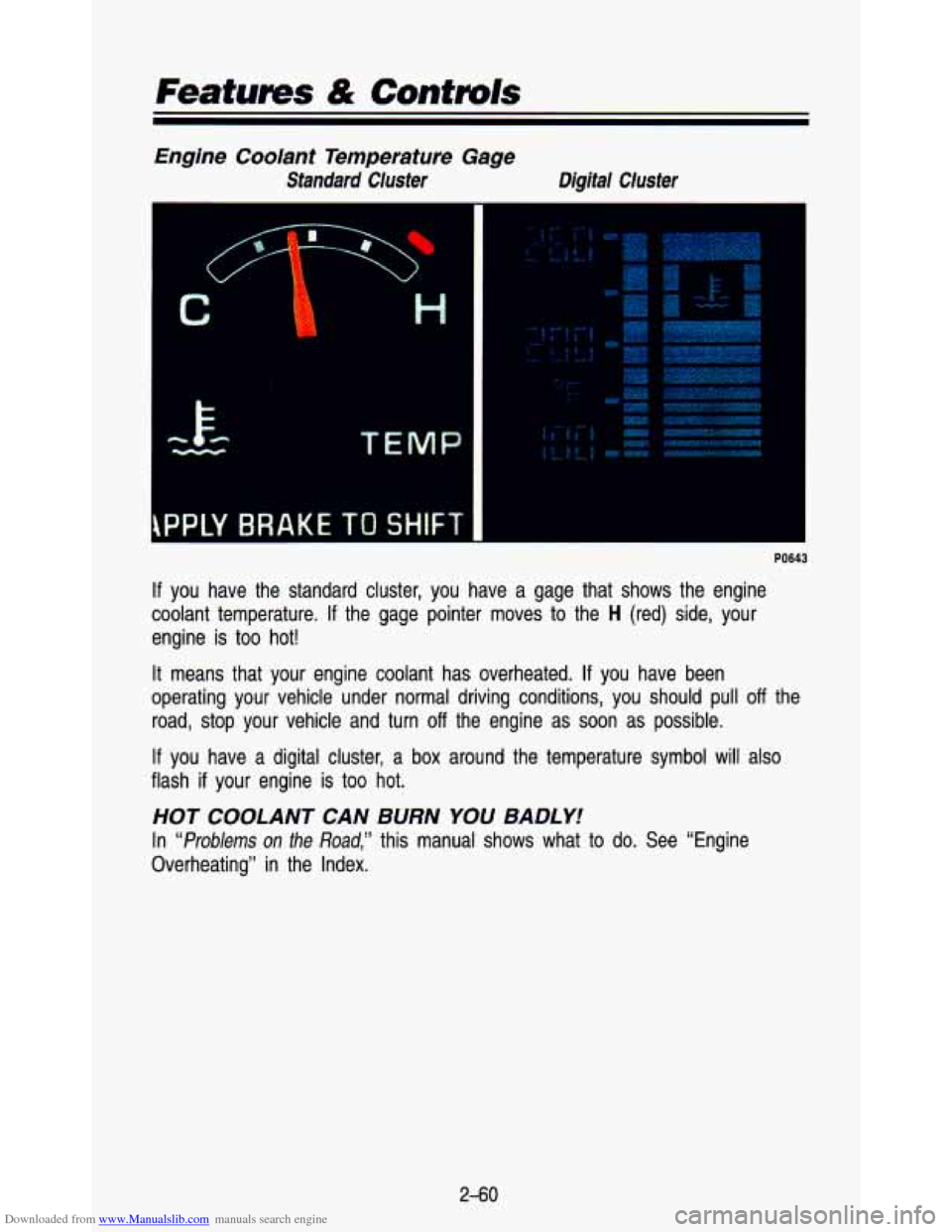
Downloaded from www.Manualslib.com manuals search engine Features & Controls
Engine Coolant Temperature Gage
Standard CIuster Digital Cluster
TEMP
PPLY BRAKE TO SHIFT
PO643
If you have the standard cluster, you have a gage that shows the\
engine
coolant temperature.
If the gage pointer moves to the H (red) side, your
engine is too hot!
It means that your engine coolant has overheated.
If you have been
operating your vehicle under normal driving conditions, you shou\
ld pull
off the
road, stop your vehicle and turn
off the engine as soon as possible.
If you have a digital cluster, a
box around the temperature symbol will also
flash
if your engine is too hot.
HOT COOLANT CAN BURN YOU BADLY!
In “Problems on the Road,” this manual shows what to do. See “Engine
Overheating” in the Index.
2-60
Page 122 of 345
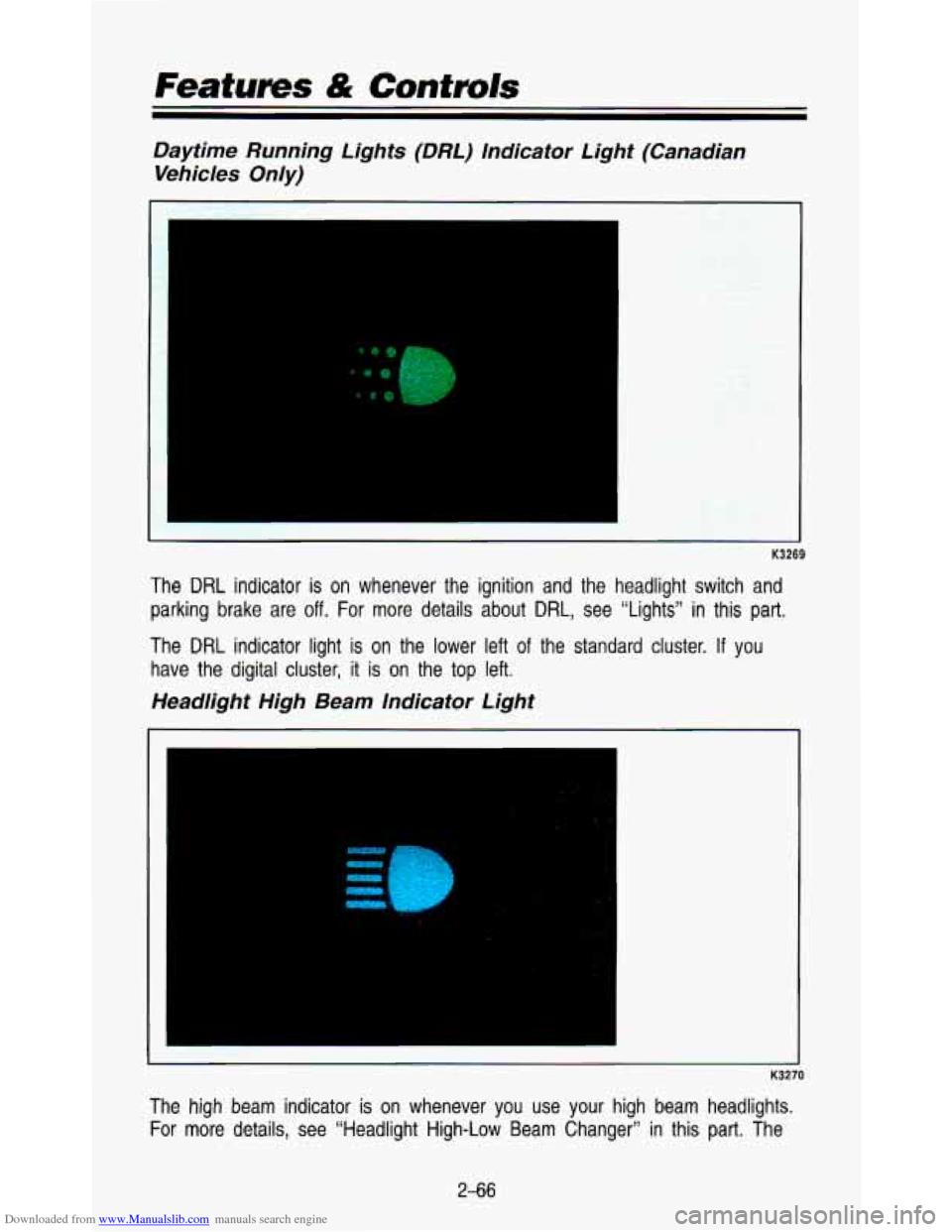
Downloaded from www.Manualslib.com manuals search engine Features & Cantmls
Daytime Running Lights (DRL) Indicator Light (Canadian Vehicles Only)
The DRL indicator is on whenever the ignition and the headlight switch and
parking brake are
off. For more details about DRL, see "Lights" in this part.
The DRL indicator light is on the lower left of the standard cluster. If you
have the digital cluster, it is on the top left.
Headlight High Beam Indicator Light
. -.
w
- K3270
The high beam indicator is on whenever you use your high beam headlights.
For more details, see "Headlight High-Low Beam Changer" in this part. The
2-66
Page 162 of 345
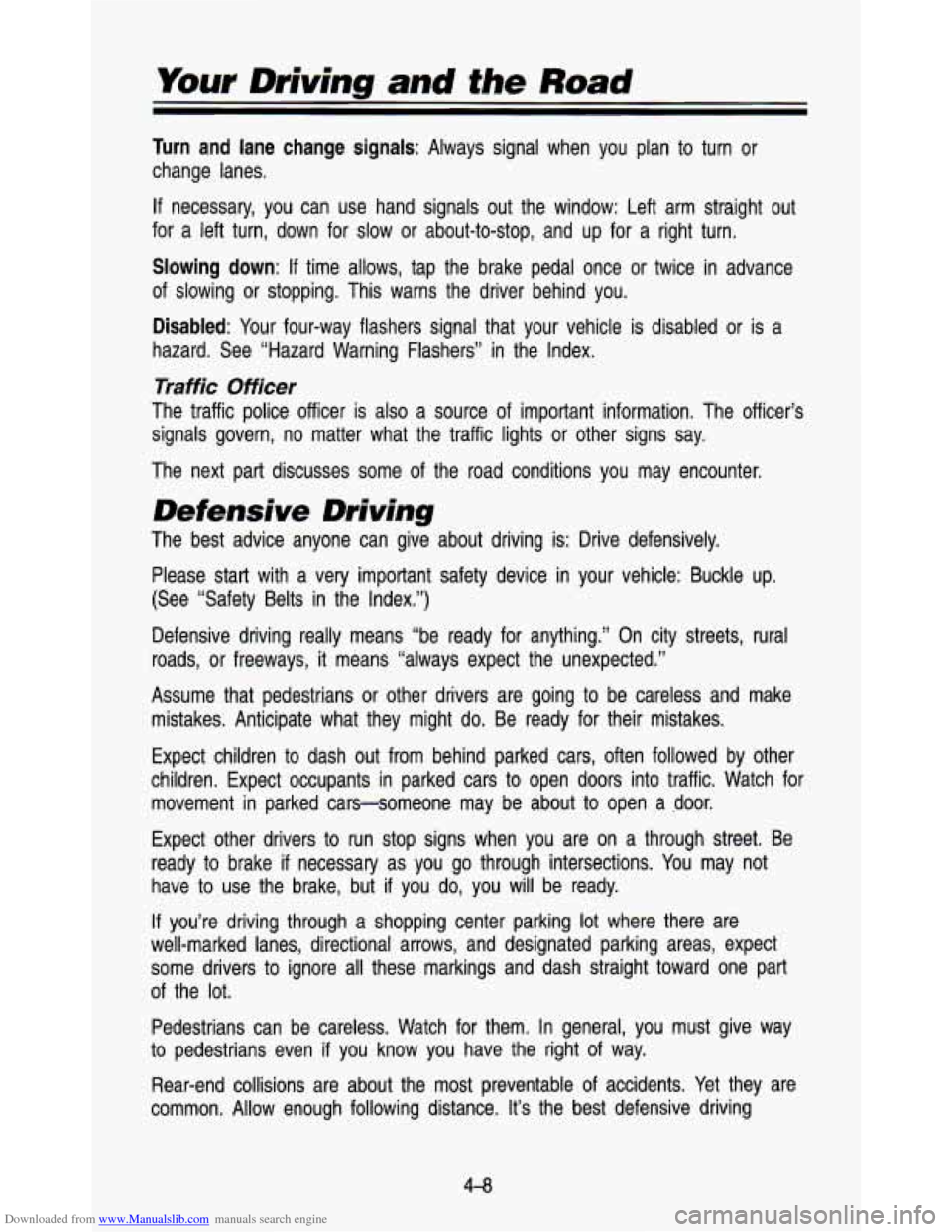
Downloaded from www.Manualslib.com manuals search engine Your Driving and the Road
Turn and lane change signals: Always signal when you plan to turn or
change lanes.
If necessary, you can use hand signals out the window: Left arm \
straight out
for a left turn, down for slow or about-to-stop, and up for \
a right turn.
Slowing down: If time allows, tap the brake pedal once or twice in advance
of slowing or stopping. This warns the driver behind you.
Disabled: Your four-way flashers signal that your vehicle is disabled or is a\
hazard. See “Hazard Warning Flashers” in the Index.
Traffic Officer
The traffic police officer is also a source of important information. The officer’s
signals govern, no matter what the traffic lights or other sig\
ns say.
The next part discusses some of the road conditions you may encounter.
Defensive Driving
The best advice anyone can give about driving is: Drive defens\
ively.
Please start with a very important safety device in your vehic\
le: Buckle up.
(See “Safety Belts in the Index.”)
Defensive driving really means “be ready for anything.’’\
On city streets, rural
roads, or freeways, it means “always expect the unexpected.”
Assume that pedestrians or other drivers are going to be carel\
ess and make mistakes. Anticipate what they might
do. Be ready for their mistakes.
Expect children
to dash out from behind parked cars, often followed by other
children. Expect occupants in parked cars
to open doors into traffic. Watch for
movement in parked cars-someone may be about
to open a door.
Expect other drivers
to run stop signs when you are on a through street. Be
ready to brake if necessary as you go through intersections. You may not
have to use the brake, but
if you do, you will be ready.
If you’re driving through a shopping center parking lot where t\
here are
well-marked lanes, directional arrows, and designated parking are\
as, expect
some drivers to ignore all these markings and dash straight to\
ward one part
of the lot.
Pedestrians can be careless. Watch for them. In general, you m\
ust give way
to pedestrians even
if you know you have the right of way.
Rear-end collisions are about the most preventable of accidents. Yet they are
common. Allow enough following distance.
It’s the best defensive driving
4-0
Page 163 of 345
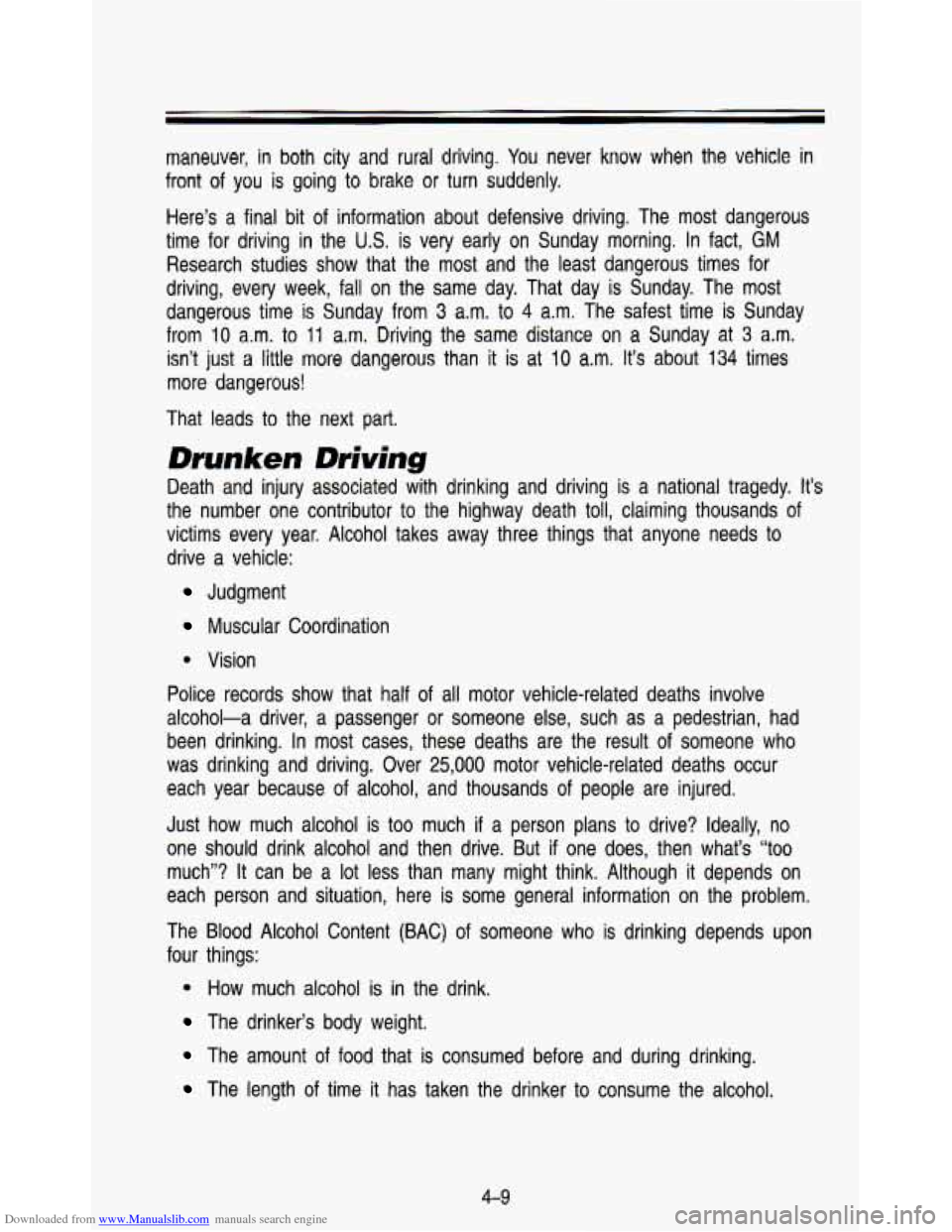
Downloaded from www.Manualslib.com manuals search engine maneuver, in both city and rural driving. You never know when the vehicle in
front of you is going to brake
or turn suddenly.
Here’s a final bit of information about defensive driving. The most dangerous
time for driving in the
US. is very early on Sunday morning. In fact, GM
Research studies show that the most and the least dangerous ti\
mes for
driving, every week, fall on the same day. That day is Sunday\
. The most
dangerous time is Sunday from
3 a.m. to 4 a.m. The safest time is Sunday
from
10 a.m. to 11 a.m. Driving the same distance on a Sunday at 3 a.m.
isn’t just a little more dangerous than it is at 10 a.m. It‘s about 134 times
more dangerous!
That leads
to the next part.
Drunken Driving
Death and injury associated with drinking and driving is a nat\
ional tragedy. It’s
the number one contributor to the highway death toll, claiming \
thousands of
victims every year. Alcohol takes away three things that anyone\
needs to drive a vehicle:
Judgment
Muscular Coordination
0 Vision
Police records show that half of all motor vehicle-related deat\
hs involve
alcohol-a driver, a passenger or someone else, such as a pedestrian, had
been drinking. In most cases, these deaths are the result of someone who
was drinking and driving. Over
25,000 motor vehicle-related deaths occur
each year because of alcohol, and thousands of people are inju\
red.
Just how much alcohol is too much
if a person plans to drive? Ideally, no
one should drink alcohol and then drive. But
if one does, then what’s “too
much”? It can be a lot less than many might think. Although it depends on
each person and situation, here
is some general information on the problem.
The Blood Alcohol Content (BAC)
of someone who is drinking depends upon
four things:
0 How much alcohol is in the drink.
The drinker’s body weight.
The amount of food that is consumed before and during drinking.
The length of time it has taken the drinker to consume the alcohol.
4-9
Page 166 of 345
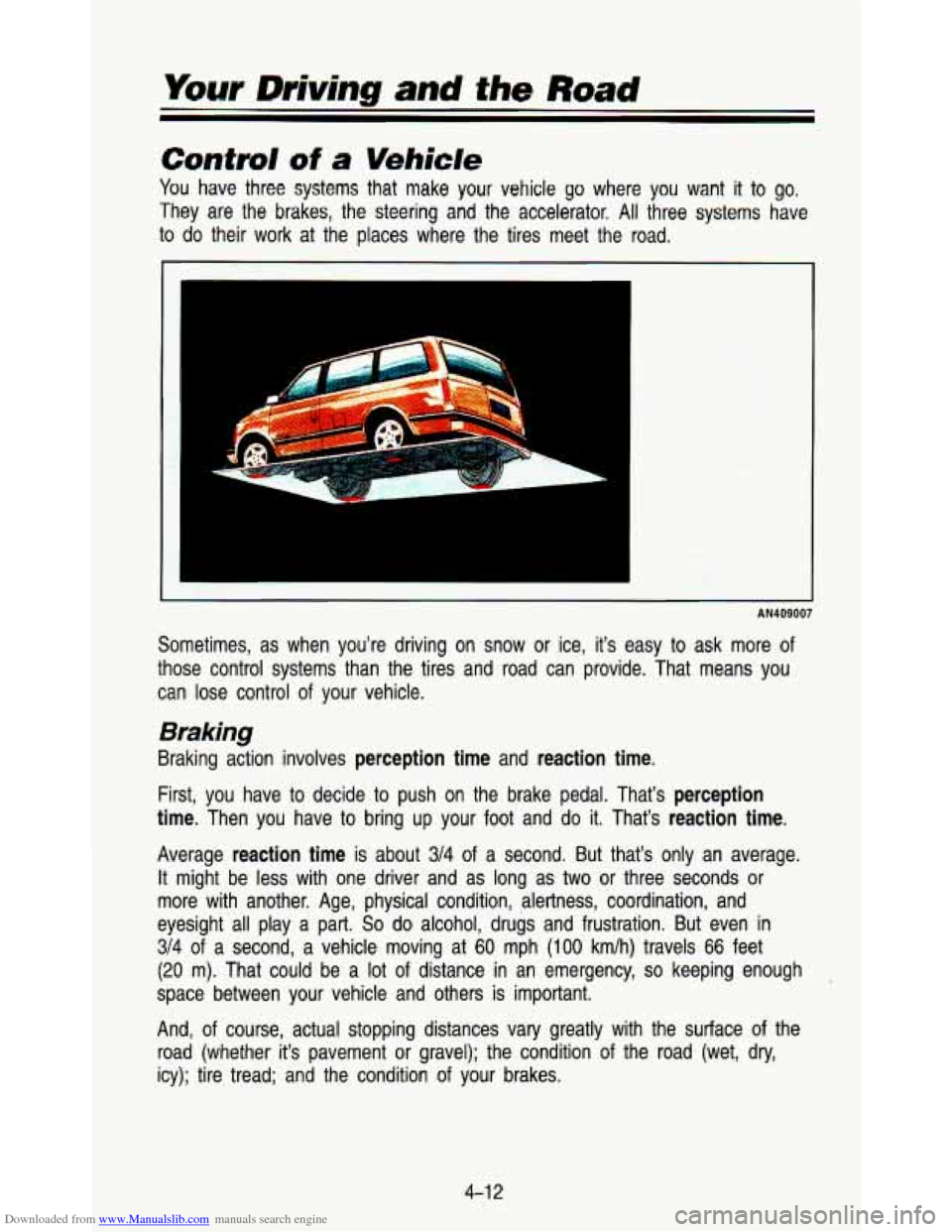
Downloaded from www.Manualslib.com manuals search engine Your Driving and the Road
Control of a Vehicle
You have three systems that make your vehicle go where you want it to go.
They are the brakes, the steering and the accelerator. All three systems have
to
do their work at the places where the tires meet the road.
f ’; 5
’. I
;::-;. I ?> - +. :
i: . ’. n --.
AN409007
Sometimes, as when you’re driving on snow or ice, it’s e\
asy to ask more of
those control systems than the tires and road can provide. Tha\
t means you
can lose control of your vehicle.
Braking
Braking action involves perception time and reaction time.
First, you have to decide to push on the brake pedal. That’s perception
time.
Then you have to bring up your foot and do it. That’s reaction time.
Average reaction time is about 3/4 of a second. But that’s only an average.
It might be less with one driver and as long as two or three seconds or \
more with another. Age, physical condition, alertness, coordinati\
on, and
eyesight all play a part.
So do alcohol, drugs and frustration. But even in
3/4 of a second, a vehicle moving at
60 mph (1 00 km/h) travels 66 feet
(20 m). That could be a lot of distance in an emergency, so keeping enough
space between your vehicle and others is important.
And, of course, actual stopping distances vary greatly with the surface of the \
road (whether it’s pavement or gravel); the condition
of the road (wet, dry,
icy); tire tread; and the condition of your brakes.
4-1
2
Page 167 of 345
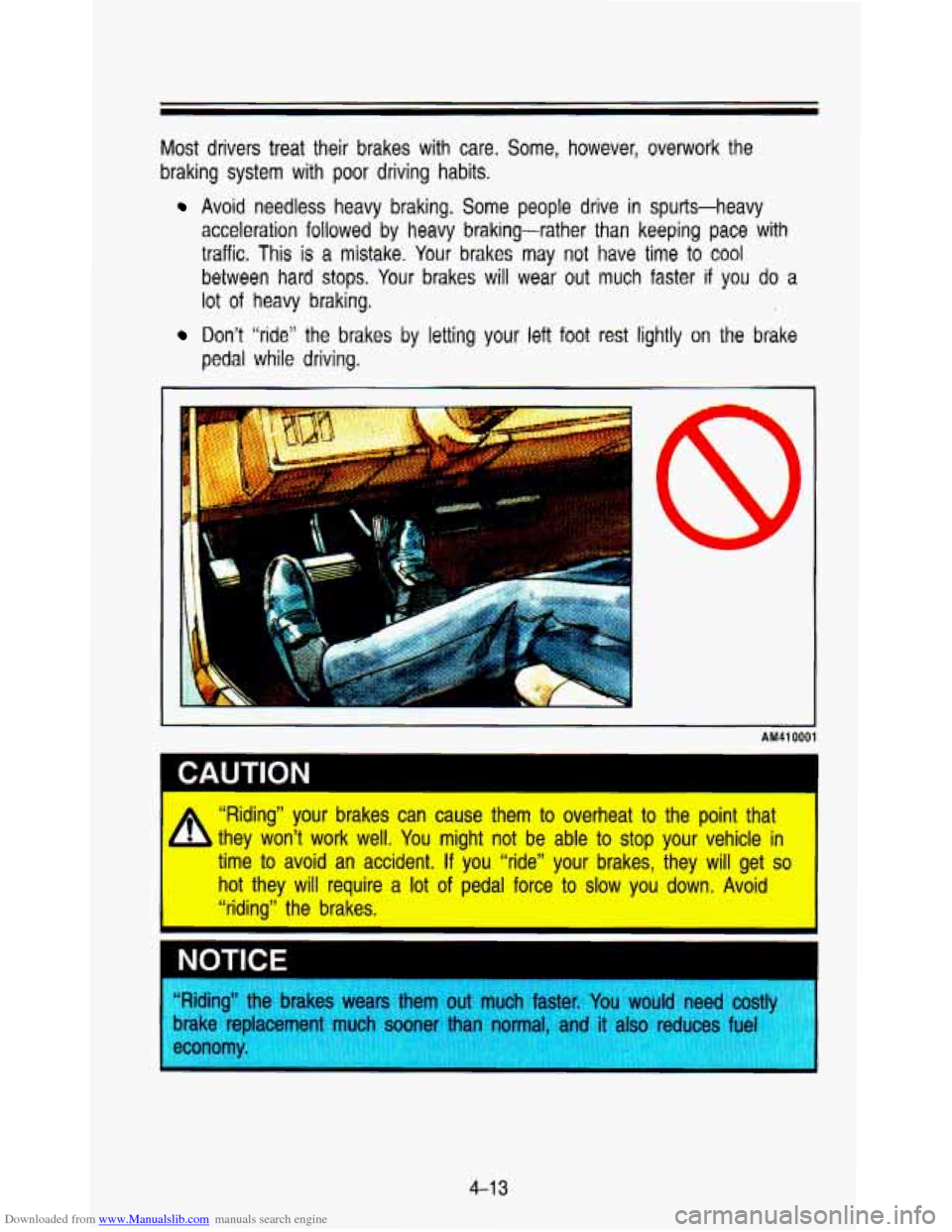
Downloaded from www.Manualslib.com manuals search engine Most drivers treat their brakes with care. Some, however, overwork the
braking system with poor driving habits.
Avoid needless heavy braking. Some people drive in spurts-heavy
acceleration followed by heavy braking-rather than keeping pace with
traffic. This
is a mistake. Your brakes may not have time to cool
between hard stops. Your brakes will wear out much faster if you do a
lot of heavy braking.
Don’t ”ride” the brakes by letting your left foot rest lightly on the brake
pedal while driving.
II
!
I AM410001
A
“Riding” your brakes can cause them to overheat to the point that
they won’t work well. You might not be able
to stop your vehicle in
time to avoid an accident.
If you “ride” your brakes, they will get so
hot they will require a lot of pedal force to slow you down. Avoid
“riding” the brakes.
1 CAUTION
I
NOTICE
“Riding .he brakes wears them out much faster. You would need costll
brake replacement much
sooner than normal. and it also reduces fuel
4-1 3
Page 168 of 345
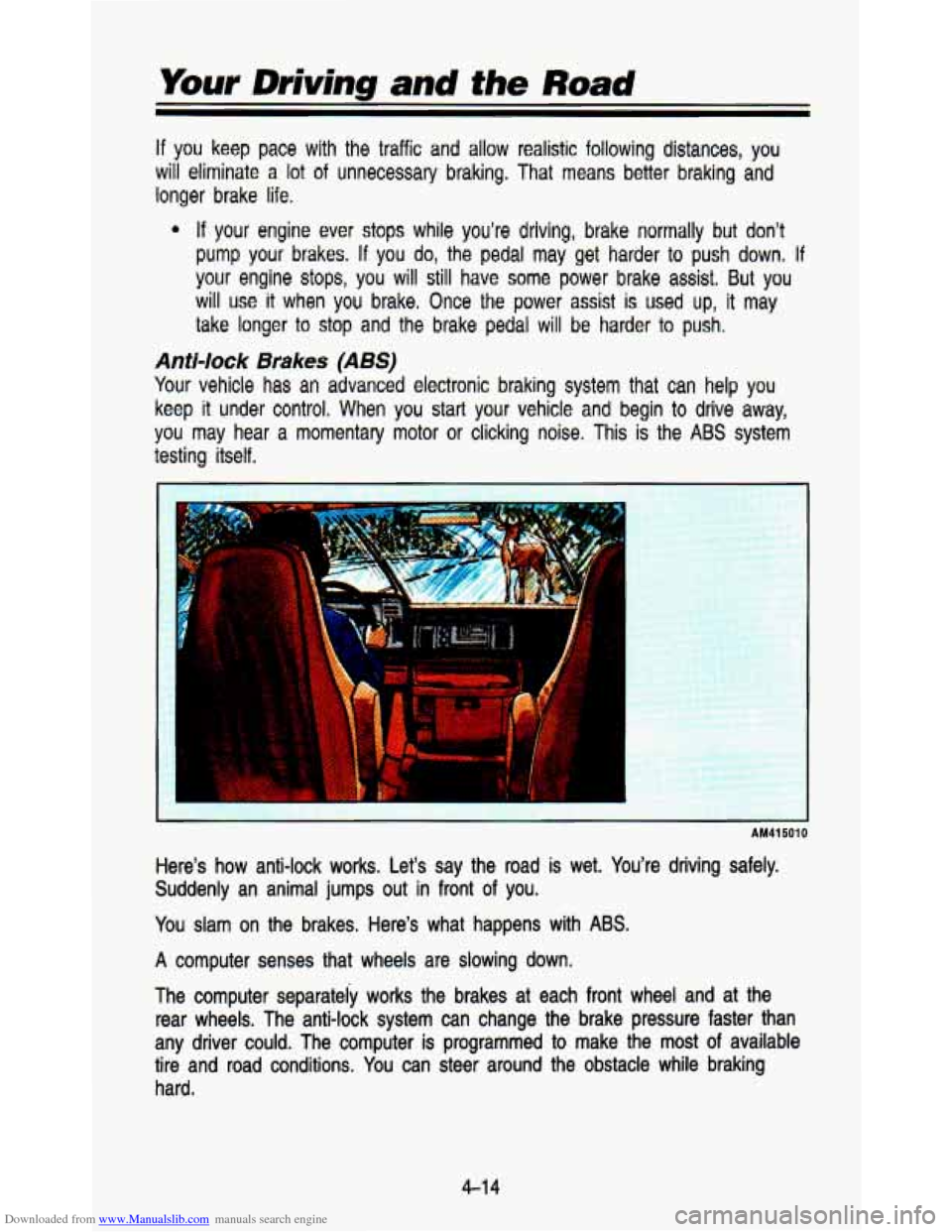
Downloaded from www.Manualslib.com manuals search engine If you keep pace with the traffic and allow realistic following distances, you
will eliminate
a lot of unnecessary braking. That means better braking and
longer brake
life.
4 If your engine ever stops while you’re driving, brake normally but don’t
pump your brakes. If you do, the pedal may get harder to push down. If
your engine stops, you will still have some power brake assist. But you
will
use it when you brake, Once the power assist is used up, it may
take longer
to stop and the brake pedal will be harder to push.
Anti-lOCk Brakes (ABS)
Your vehicle has an advanced electronic braking system that can help you
keep
it under control. When you start your vehicle and begin to drive \
away,
you may hear a momentary motor
or clicking noise. This is the ABS system
testing itself.
AM41 501 0
Here’s how anti-lock works. Let’s say the road is wet. You’re driving safely.
Suddenly an animal jumps out in front of you.
You slam on the brakes. Here’s what happens with
ABS.
A computer senses that wheels are slowing down.
The computer separately works the brakes at each front wheel a\
nd
at the
rear wheels. The anti-lock system can change the brake pressure\
faster than
any driver could. The computer is programmed
to make the most of available
tire and road conditions.
You can steer around the obstacle while braking
hard.
4-1 4
Page 169 of 345
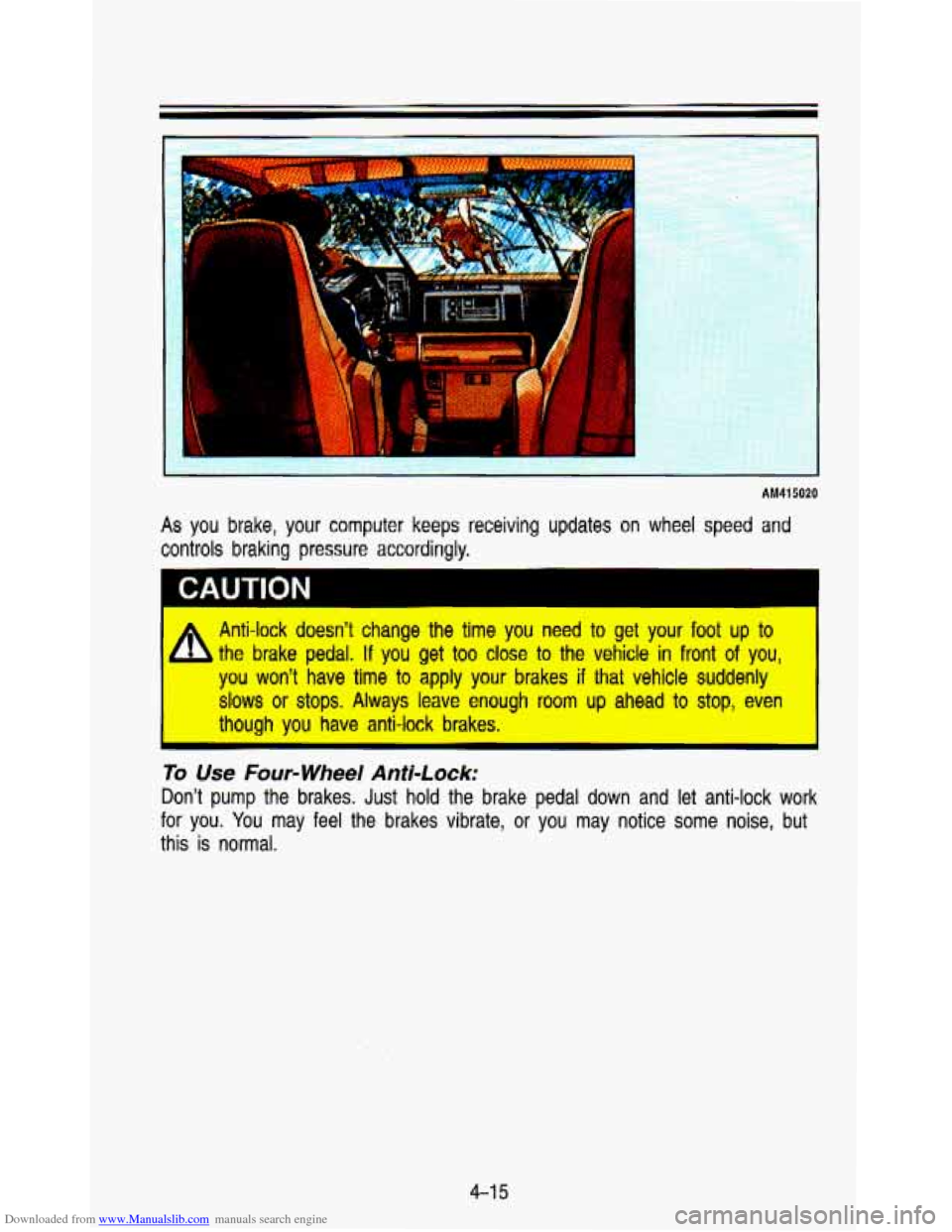
Downloaded from www.Manualslib.com manuals search engine ...
AM41 5020
As you brake, your computer keeps receiving updates on wheel speed and
controls braking pressure accordingly.
CAUTION
Anti-lock doesn’t change the time you need to get your foot up to
the brake pedal. If you get too close to the vehicle in front of you,
you
won’t have time to apply your brakes if that vehicle suddenly
slows or stops. Always leave enough room up ahead to stop, even
though
you have anti-lock brakes.
To Use Four-wheel Anti-Lock:
Don’t pump the brakes. Just hold the brake pedal down and let anti-lock work
for you. You may feel the brakes vibrate,
or you may notice some noise, but
this is normal.
4-1 5